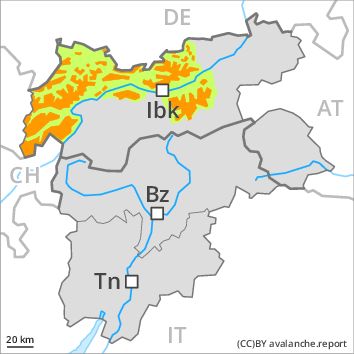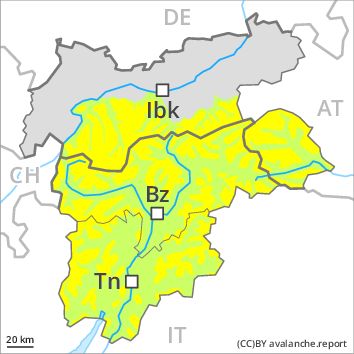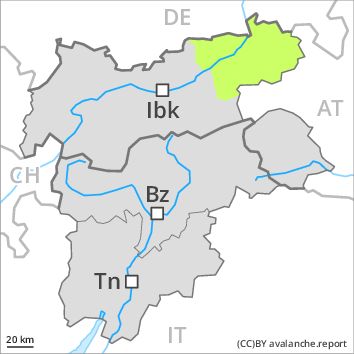Regions
Western Verwall Mountains, Eastern Verwall Mountains, Allgäu Alps, Silvretta, Samnaun Mountains, Eastern Lechtal Alps - Ammergau Alps, Mieming Mountains, Western Tuxer Alps, Karwendel Mountains, Eastern Tuxer Alps, Western Lechtal Alps, Central Lechtal Alps, Grieskogel Mountains

Danger level
Danger Level 3 - Considerable above the treeline
Danger Level 1 - Low above the treeline
Avalanche Problem
Wind-drifted snow above the treeline, N-NE-E-SE-S-SW-W-NW
Persistent weak layer above 2200m, S-SW-W

Wind slabs are to be evaluated critically. Weakly bonded old snow requires caution.
Fresh and somewhat older wind slabs must be evaluated with care and prudence in all aspects above the tree line, especially adjacent to ridgelines and in gullies and bowls. The number and size of avalanche prone locations will increase with altitude. Avalanches can additionally in isolated cases be released in the weakly bonded old snow on steep south, southwest and west facing slopes. In areas where the snow cover is rather shallow the avalanche prone locations are more prevalent.
Avalanches can as before be released, even by a single winter sport participant and reach medium size. Snow sport activities outside marked and open pistes call for experience in the assessment of avalanche danger.
Snowpack
dp 6: cold, loose snow and wind
dp 4: cold following warm / warm following cold
Brittle wind slabs have formed in particular on northeast, east and southeast facing slopes. 10 to 15 cm of snow, and up to 20 cm in some localities, will fall. As a consequence of fresh snow and stormy weather the wind slabs will increase in size additionally. They are bonding poorly with the old snowpack in all aspects above the tree line.
Faceted weak layers exist in the top section of the old snowpack on steep sunny slopes.
Tendency
As a consequence of fresh snow and stormy weather there will be an increase in the avalanche danger.
Regions
Sexten Dolomites, Latemar, Southern Adamello, Adamello - Presanella, Northern Brenta - Peller, Bondone and Stivo, Folgaria - Laverone, Southern Brenta, Southern Lagorai, Northern Lagorai, Val Müstair Alps, Langtaufers, Schnals Ridge, Southern Stubai Alps, Southern Zillertal Alps and High Tauern, Northern Oetz and Stubai Alps, Saldurn-Mastaun Ridge, Texel Mountains, Sarntal Alps, Western Pfunderer Mountains, Glockturm Range, Maddalene, Pine' - Mocheni Valley, Eastern Pfunderer Mountains, Durreck Range, Weißkugel Range, Western Rieserferner Mountains, Gurgler Range, Western Deferegger Alps, Central Stubai Alps, Ortler Range, Northern Zillertal Alps, Ulten Valley, Venediger Range, Eastern Nonsberger Alps, Eastern Rieserferner Mountains, Northern Dolomites of Fiemme, Glockner Range, Gröden Dolomites, Primiero - Pale di S. Martino, Eastern Deferegger Alps, Prags Dolomites, Prealps, Schober Mountains, Cembra Valley, Lienzer Dolomites, Vallarsa, Western Nonsberg Alps, Fassa Valley, Sole, Pejo and Rabbi, Ledro Valley, Paganella, Marzola - Valsugana

Danger level
Danger Level 2 - Moderate above the treeline
Danger Level 1 - Low above the treeline
Avalanche Problem
Wind-drifted snow above the treeline, N-NE-E-SE-S-NW

Wind slabs are to be evaluated critically.
Fresh and somewhat older wind slabs must be evaluated with care and prudence in particular on northwest to east to south facing aspects above the tree line, especially adjacent to ridgelines and in gullies and bowls. The number and size of avalanche prone locations will increase with altitude.
Avalanches can as before be released, even by a single winter sport participant and reach medium size. Snow sport activities outside marked and open pistes call for experience in the assessment of avalanche danger.
Snowpack
dp 6: cold, loose snow and wind
Brittle wind slabs have formed in particular on northwest, east and south facing slopes. In some localities up to 10 cm of snow. will fall. As a consequence of fresh snow and stormy weather the wind slabs will increase in size additionally. They are bonding poorly with the old snowpack above the tree line.
Tendency
As a consequence of the storm force wind there will be only a slight increase in the avalanche danger.
Regions
Brandenberg Alps, Western Kitzbühel Alps, Wilder Kaiser Mountains - Waidring Alps, Eastern Kitzbühel Alps

Danger level
Danger Level 1 - Low
Avalanche Problem
Wind-drifted snow above the treeline, N-NE-E-SE-S-NW

Wind slabs require caution.
Fresh and somewhat older wind slabs must be evaluated with care and prudence in particular on northwest to east to south facing aspects above the tree line, especially adjacent to ridgelines and in gullies and bowls. The number and size of avalanche prone locations will increase with altitude. Avalanches can be released by a single winter sport participant, but they will be small in most cases.
Snowpack
dp 6: cold, loose snow and wind
Brittle wind slabs have formed in particular on northwest, east and south facing slopes. In some localities up to 10 cm of snow. will fall. As a consequence of fresh snow and stormy weather the wind slabs will increase in size additionally. They are bonding poorly with the old snowpack above the tree line.
Tendency
As a consequence of the storm force wind there will be only a slight increase in the avalanche danger.



